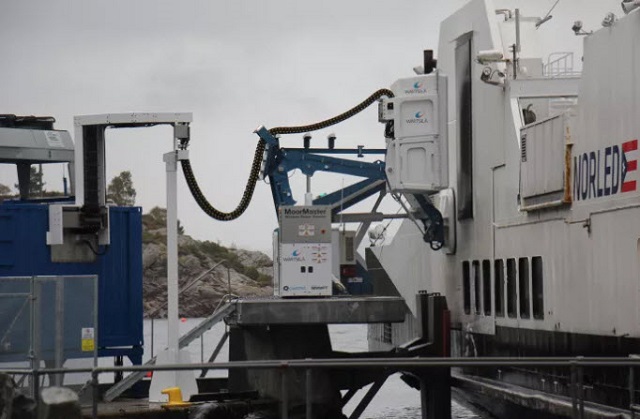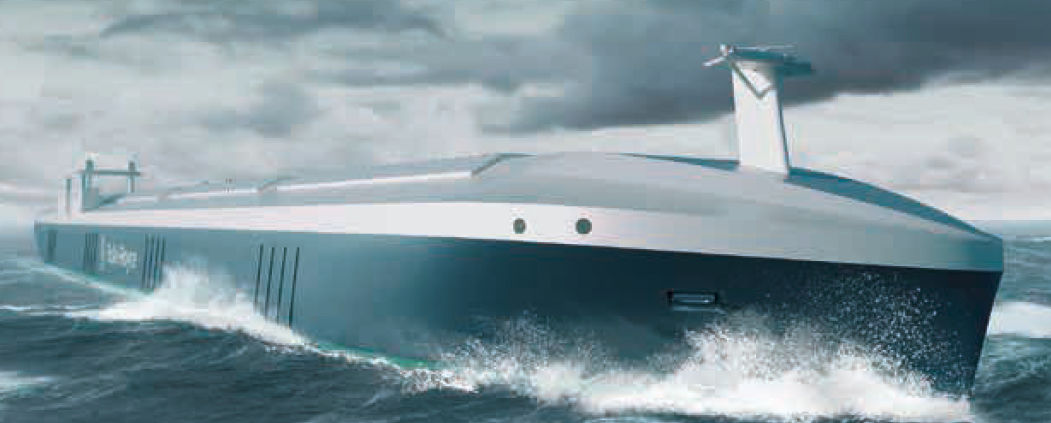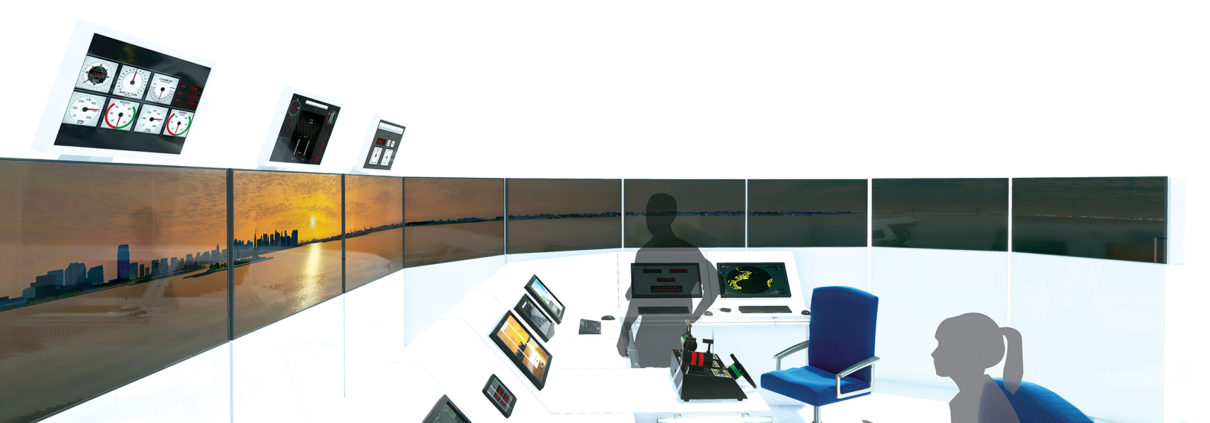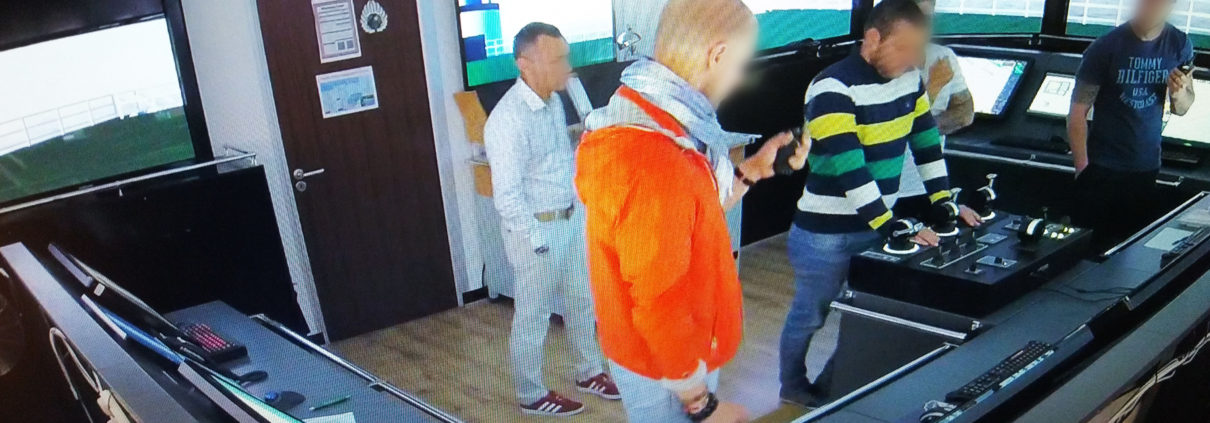Maritime simulators are now the modern way to gain competence. Beginning with basic navigation but now extending to almost every aspect of ship operation including specialist aspects such as crane handling and towing, They have advanced hugely since the early days when only a basic computer screen was available and now offer a degree of realism that is quite amazing.
Maritime simulators, their use and the quality of instruction are given a whole section (A-I/12) of the STCW 2010 text. There are two performance standards – one applying to simulators used for training and the other for simulators used to assess competence. There are also some additional requirements for radar and ARPA simulators.
Throughout the tables that are included in STCW 2010 detailing the minimum standards required for different ranks and specialisations, maritime simulators are mentioned in the majority of cases as being a method for demonstrating competence.
The use of maritime simulators is ranked third in the choice of ‘Examination and assessment of evidence obtained’ after approved in service experience and approved training ship experience. This is confirmation of the view that modern seafarer training is becoming more aimed at competence than experience.
A recruitment drive
The 2015 five-yearly BIMCO/ICS survey identified a current shortfall of about 16,500 officers (2.1%), but sees a need for an additional 147,500 officers by 2025 to service the world merchant fleet.
The global supply of officers is forecast to increase steadily, but this is predicted to be outpaced by increasing demand. Officer categories in especially short supply include engineer officers at management level and officers for specialised ships such as chemical, LNG and LPG carriers.
The report suggests that in the past five years the industry has made good progress with increasing recruitment and training levels and reducing officer wastage but unless training levels are increased significantly, however, the growth in demand for seafarers could generate a serious shortage in the total supply of officers.
There is some anecdotal evidence that encouraging new officer recruits is becoming more difficult especially in Europe and the west. However, the slowdown in shipping that has occurred simultaneous with and since the survey was done may reduce the need for new officers and may even encourage some shore-based personnel to return to sea. To do that there will be a need for most of them to attend refresher training at a maritime simulator centre.
Maritime simulators used in training centres
Today, every training centre worth its salt will have a maritime simulator of some sort – most likely supplied by Transas, Kongsberg or VSTEP. The IMO has attempted to build a database of approved simulators which can be accessed in the GISIS database. The database is free to use but ShipInsight’s examination of the list shows it to be somewhat underpopulated with many omissions.
The market is not limited to just the three companies mentioned above. PC Maritime, BMT Rembrandt, FORCE Technology, Marin and ARI are other players that are active in the sector – sometimes serving niche markets but often with a wide range of products.
Maritime simulators come in many sizes and guises with even a simple PC and monitor able to meet the performance standards demanded of simulators by certificate issuing authorities. Although a PC simulator can be controlled by mouse and keyboard it is common to use a special controller that makes use of control panels that replicate typical bridge controls.
Those entering the industry today are more than likely to cut their teeth in ship handling and navigation on a simulator rather than on the bridge of an actual ship. Stand-alone simulators representing a particular piece of equipment or system are meant for equipment familiarisation, refreshment of knowledge and some basic training. Classroom simulators which are usually desktop PCs are intended for operational training and certification. For instance, ECDIS training, which became mandatory according to the latest STCW requirements, can be done on a class or mini-lab simulator.
While full mission simulators include a lot of controls or as in the most advanced training centres, replica of the real equipment. Their primary goal is conducting advanced training and certification, certain configurations and courses – DP systems are a good example – can allow even for sea time reduction training.
Specific technical requirements for maritime simulators
- Requirements to simulate specific type of equipment, control and operation systems including mimic and logic rather than working with a generic solution;
- Mathematical modelling becomes a major value in the product chain due to complexity of the reflected processes and requirements for precision and computation speed;
- There is more interest expressed in integrated solutions where various types of simulators act in a common training scenario. The increased sophistication of today’s vessels and terminals has created intense demand for total vessel integrated training. This training need has not only expanded to the combined navigation/cargo/engineering integration, but moved past the ship/shore interface to include the terminal as well.
Transas and other market leaders say they are focusing investment on development of technological tools that will help to overcome those challenges. The most important part of this process is introduction of new visual object oriented modelling package and physical libraries to speed up the simulator manufacturing and make it extremely flexible and competitive. One of the recent developments by Transas is a new mechanical interaction in its navigational simulators. This function allows for raising the training realism to an unprecedented high level and provides new opportunities for emergency scenario training.
With current development of technology, there is no doubt that simulators can provide realistic and cost-effective training that should be supplemented by sea time. In addition, marine simulation allows for practicing troubleshooting procedures which cannot be done in real conditions without risk to personnel and assets.
Most simulators are in training establishments but some operators such as Star Cruises, Farstad Shipping and Maersk Training have established their own centres. The most recent operator to develop its own simulator centre is Carnival Cruises with the CSMART (Center for Simulator Maritime Training) training facility located in Almere, Netherlands.
CSMART offers two full mission bridge simulators, six part-task bridge simulators and the ability to simulate fixed propeller and azipod simulation. On the engineering side CSMART offers two full mission Engine Control Rooms with four machinery outstations and 16 part-task Engine Room simulators.
Sharing the simulation experience
While such operators could make full use of their own simulators, some will also offer training for other operators. Companies that cannot justify having their own facility may be able to lease a simulator for their private use for a period or else will have to send staff on open training courses. The advantage of having sole use is that own procedures and training programmes can be accommodated.
For some applications, portable simulators can be better suited than large fixed installations. Transas has designed a portable version of a simulator for ECDIS courses. A trainer can bring it to a customer’s site or even onboard reducing travelling and accommodation costs for trainees and saving time.
However, mobile solutions cannot replace fixed simulators for advanced training and certification for certain areas. Where it is possible to replicate the bridge of an existing – or planned – vessel, complex exercises in both ship handling and crew resource management operations can be carried out.
Simulator training need not be restricted to one aspect of a ship or indeed to a single ship. With bridge and engine room simulators common place, connecting the two together can dramatically increase the training scenario permutations. Even more variety can be added if simulators can be run in a mode that enables multiple vessels to operate in a single exercise. This could involve vessel and tugs or vessels navigating independently in confined waters.
Training exercises of this type are of particular value if the purpose of the training is to develop bridge team management skills as several trainees will be undertaking training at the same time. Simulators have been recognised as a very good tool for this type of training. The skill of the trainer can also add value in that it will be possible for him to change the parameters if it seems desirable. This could for example involve a possible mechanical problem, loss of steering, deterioration in weather and visibility, an encounter with another vessel or any similar problem that could arise at any time.
Some simulator developers have modelled actual port environments allowing the trainees to experience bringing a vessel into a specific port or berth. This sort of exercise can be valuable for new crew joining a ship that regularly calls at the particular port or to investigate potential problems if a new port is being added to a ship’s operational pattern. Not only crew but pilots can profit from this sort of training.
Original Source: https://shipinsight.com/virtual-reality-maritime-simulators-training-seafarers/









